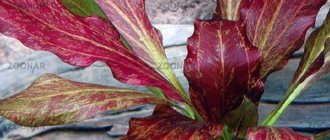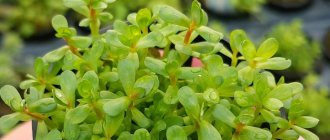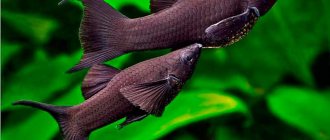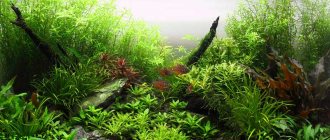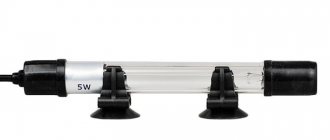The plant is not suitable for beginner aquarists. The manipulations associated with its initial placement are quite labor-intensive. The engraftment of this moss is a painstaking, exquisite work. But the result is worth the effort. An overgrown liverwort colony becomes a decoration for any aquarium.
In domestic reservoirs, Liver Moss is rare. The conditions for maintaining and growing this crop are still poorly understood. But it definitely deserves attention and is a godsend for the imagination of an aquascaper.
Bryophytes are the oldest specimens of the subkingdom of Green plants. About 6,000 species of mosses are known to science. In aquarium farming, Riccia floating and Pellia are mainly used.
Liver Moss made its debut as an aquarium culture in 2002. It belongs to the monotypic genus Monosolenium.
It was originally known under the incorrect name Endiviifolia or Endiviaefolia.
This crop is larger than Riccia, its closest relative. Judging by its external characteristics, the liverwort is a darker version of Riccia floating.
Morphological characteristics:
- The leaves are flat, up to 7-9 mm wide, with forks 1-1.5 cm long. They branch every 2 cm. They form a beautiful colony in the form of a hemisphere. Rhizoids appear on the reverse side of the leaf, with the help of which the moss is fixed to driftwood and stones in an airy state.
- Color - light green, olive.
- When immersed, it weakly clings to foreign objects. Under unfavorable conditions, it lengthens, which adversely affects the splendor of the bushes.
- Talom - forked-branched, leaf-shaped.
Of course, liver moss resembles Riccia. But they are a floating culture. It will take a lot of effort to grow this species as a ground cover. Since Monosolenium tenerum is heavier than water, it always grows along the bottom.
Distribution area
In the natural environment, liver moss is rare. It prefers the moist, swampy soil of Thailand, Taiwan, Nepal, and the southern regions of China.
It is also found on the Hawaiian Islands. Rarely grows in Japan and India. Loves shaded areas and nitrogen-rich soils. In the natural environment, the underwater form does not exist.
Decorative properties of Monosolenium tenerum
Moss does not have rhizoids and, accordingly, is not attached to the substrate. Monosolenium tenerum, Pellia tends to lose individual pieces of the thallus, which grow in small colonies in the form of small hemispherical pillows. Such colonies move freely along the bottom, but look very decorative.
Moss monosolenium is grown in a damp terrarium or in plastic bowls on a window sill. Pellias are used as decorations on the foreground or background of terraces. Pellia is demanding of bright light, but it does not die in partial shade, only its growth is dulled and its growth becomes thinner. As a result, the colony becomes less decorative, the structure thins out and it will be easier to break it. With intense light and sufficient CO2, it will delight you with its beauty for a long time. On-site land management services from the SVZK company.
Growing and care
Initial placement of this plant in the aquarium is not an easy task. The aquarist must take care that the moss does not float freely. But if this succeeds, as it grows, the Liver Moss will form nice emerald cushions at the bottom.
General care recommendations:
- Can be planted in aquariums, nano-aquariums, wet greenhouses, and plastic containers. In the airy state, the liverwort turns from light green to a soft olive hue. And the leaves with this content become stronger. The distance between the branches is reduced to 8 mm.
- Liver moss looks impressive in company with Eleocharis Parvula and Glossostigma Povoinichkova. The rich green color of the leaf blades contrasts favorably with the lighter leaves.
- Suitable for foreground and middle ground.
- Like many marsh plants, it should be regularly moved to the paludarium for short periods of rest.
- Since this plant is very fragile, you need to be extremely careful when transporting it. Otherwise it may fall apart.
- This culture is incredibly beneficial. Among the undeniable advantages are the saturation of the aquatic environment with oxygen and active participation in mineral metabolism. This type of moss is also an excellent environment for ciliates, which make up the daily diet of aquarium fish.
Colonies of Liver Moss line the bottom beautifully, making this plant attractive to most aquarium designers.
Optimal water parameters
Can be grown in a wide temperature range.
Recommended hydrochemical parameters:
- temperature - 18-26°C;
- pH - 4-7;
- hardness - 0-14°dGH.
The plant feels great at 32°C and does not die at 10°C. Under favorable conditions and supply, carbon dioxide becomes covered with oxygen bubbles.
Lighting requirements
Like other types of mosses, liverwort loves intense light. In shading, growth slows down, and the thallus becomes thinner to 3 mm. The distances between the branches increase to 2.5 cm.
As a result, a looser structure is formed, which quickly breaks down. The optimal length of daylight is 12 hours.
Soil quality
Various substrates can be used to grow moss.
The need for feeding
Liver Moss does not require additional fertilization.
Benefit
Liver mosses are very useful for the aquarium:
- Transform the pond;
- Ensure mineral metabolism;
- Saturate the water with oxygen;
- Filter your water;
- Create shade for shade-loving fish;
- Hide fry and shy fish;
- Create conditions for the creation of spawning nests;
- Provide adequate habitat for the breeding of ciliates, which are the diet of most fish.
Sources:
• https://RibnyDom.ru/rasteniya/pechenochnye-mhi-kak-predstaviteli-nizshih-rastenii-v-akvariyme.html • https://aquarium-fish-home.ru/uncategorized/pechenochnyj-mox-opisanie-foto -razmnozhenie-soderzhanie/.html • https://5stihiynn.ru/kak-vyrastit-pechenochnyj-moh/ • https://asebo.ru/rasteniya/pechenochnye-mhi-nizshie.html
[collapse]
Features of reproduction
Reproduction occurs using spores. If it is necessary to increase the colony, the following manipulations must be performed:
- separate a small layer from the mother bush;
- place a fragment of moss in a separate container on a piece of driftwood or stone;
- after the transplanted part has acquired new shoots, it is transplanted into the aquarium.
At the beginning of autumn, Liver Moss forms brood buds that produce young shoots.
Landing
Liver moss reproduces both sexually and vegetatively.
The process of planting plants in a new aquarium is not at all complicated; part of the plant that you have, or can be purchased at a pet store, should be planted in the aquarium on a substrate.
09:02
How to grow and propagate moss at home
06:32
Java moss growing on a windowsill
03:29
How to grow aquarium mosses on padding polyester
Useful lifehacks
Here are some proven tips for growing Liver Moss:
- Because the plant's thaw is so fragile that it won't break, it shouldn't be placed in fast-flowing areas.
- Liverwort and Red Loricaria and duckweed should not be placed in the same aquarium. The latter culture quickly grows throughout the tank and begins to conflict with the liverwort.
- Co-location with herbivorous fish is excluded. Possible proximity to guppies, fighting cockerels and barbs.
- A successful combination is growing next to Eleocharis. In this case, the moss will not fly away even in strong currents.
Description
Monosolenium has a significant size. The thallus of the plant has a leaf-like and branched shape. The width of moss leaves does not exceed 9 mm. The leaves are located at a distance of 15–20 cm. The leaves have a similar arrangement to a hemisphere.
Since this species is distinguished by its considerable weight, almost the entire bottom of the tank is covered with mosses. Therefore, this vegetation is often used by experienced aquarists and designers who design aquariums, large tanks, and containers with phenotypes.
It is problematic to create a composition from mossy plants in an aquarium. This is because such vegetation is fragile. Therefore, only true aquarium masters can handle the job.
Appearance Monosolenium or Pellia
Monosolenium is a liver moss, some parts of which resemble leaves, known in narrow circles as thallus. The branch-like parts of the plant are formed into dense thickets.
The wide middle rib ensures the recognition of moss. This family of monosoleniums has translucent branched vegetative components. It is found in dark green shades and even light olive. In its structure, the plant does not differ from green leaves 1-2 cm, with forks up to 1.5 cm. The color of light green olives will definitely attract your attention to monosolenium. If you look closely, it turns out that its leaves are flat, branched every 1-2 cm, forming a luxurious colony. Rhizoids are located below, thanks to them the plant attaches to the stones. Since pellia is heavier than water, its location at the bottom forms spectacular pillows. Reproduction occurs thanks to reports, and spores are formed in plants located on the ground. Pellia has much in common with Riccia, only larger. Monosolenium tenerum is often confused with Lomariopsis lineate; mjss Monosolenium tenerum is distinguished by the presence of a central, pronounced vein, and a more rounded thallus.
Adviсe
- Liverwort grows quickly in good light. Riccia floating on the surface forms a carpet that prevents oxygen from entering the water. Remove excess plant from the surface.
- Due to their structure, plants retain food particles, which reduce water quality over time. Liver moss cannot be thoroughly cleaned without damaging the structure. The way out of the situation would be to purchase a fish feeder. The device will not allow parts of food to spread throughout the entire aquarium and will teach the fish to eat in one place. Place the moss on the opposite side of the feeder.
- For lighting, use LED, metal halide or fluorescent lamps. Avoid incandescent lamps; they will not provide the moss with enough light and will quickly heat the water.
- Do not plant liver bryophytes in the same aquarium with duckweed. Plants greatly shade the aquarium and drown out each other.
- Remember that any flora absorbs oxygen at night. An excess of plants leads to oxygen starvation of fish and other aquarium inhabitants.
Sources:
- https://63aquamir.ru/pelliya-ili-pechenochnyj-moh-monosolenium-tenerum.html
- https://zoogradspb.ru/akvariumnye-rasteniya-vse-o-rybkah/monosolenium-tenerum-ili-moh-pelliya-soderzhanie-foto-video-obzor.html
- https://aquarium-fish-home.ru/uncategorized/pechenochnyj-mox-opisanie-foto-razmnozhenie-soderzhanie/.html
- https://RybkiVBanke.ru/akvariumnye-rasteniya/pechenochnui-moh
- https://rybkies.ru/rastenia/pechenochnye-mhi.html
[collapse]
